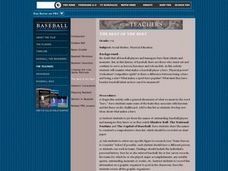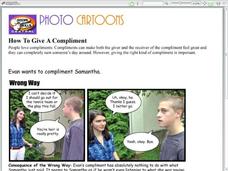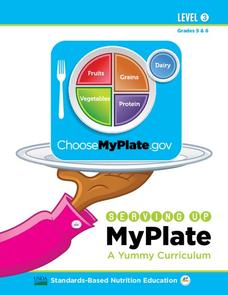Curated OER
The Best of the Best
Young scholars participate in a discussion about the definition of the word 'hero'. They research baseball players and managers and then engage in a formal debate about the merits of their subjects.
Curated OER
Your identity, your heritage
Students list memorable moments fro childhood. They complete the worksheet "Your identity, your heritage." Students look a sites regarding genealogy and discuss information about their families' genealogy or heritage. Students visit the...
Curated OER
Chalkboard Relay
Students solve addition facts. In this computation lesson, students participate in a relay activity where one player writes a number on the chalkboard and the second player writes a second number underneath it. The second player tags a...
Curated OER
Powerful Patterns
Students use logical thinking to create, identify, extend and translate patterns. For this pattern lesson, students make patterns with objects, numbers, and shapes. Students extend and translate these patterns in several modalities...
Curated OER
Places Where Women Made History
Using places can help students identify with the history-making women associated with them.
US Environmental Protection Agency
Sea Level: On the Rise
With the global temperature on the rise, the effects of climate change are starting to be seen. However, many people have a difficult time conceptualizing the long-term effects, such as sea levels rising. Given an easy and effective...
US Department of Agriculture
Serving Up My Plate
Offer your youngsters an extra helping of nutritional knowledge and healthy tips with this resource, which centers around the MyPlate nutritional guide and offers three "courses" of plans and worksheets on the food groups and the...
Social Skills Central
Ready, Set, Respond!
When faced with a difficult situation, do you respond selfishly, face it head on, or ignore the problem? This game encourages learners to evaluate the wide range of reactions we can have to problematic situations, and how our responses...
Virginia Department of Education
A Salt Marsh Ecosystem
What a web we weave. Pupils use yarn as the primary resource to create a web depicting the intricacies of a salt marsh ecosystem. They participate in a question and answer session, which leads to an in-depth facilitated discussion about...
Curated OER
Nicotine addiction and youths
Students read CNNfyi article: "Nicotine addiction can begin in days, study says," and have class discussion about the effects of nicotine on the human body.
NOAA
Ocean Layers II
Now that you know the ocean has layers, let's name them. The seventh installment of a 23-part NOAA Enrichment in Marine sciences and Oceanography (NEMO) program covers terminology associated with ocean layers, such as thermocline and...
Cornell University
Beam Focusing Using Lenses
Explore optics using an inquiry-based experimental approach! Young scholars use a set of materials to design and build a unit capable of focusing a beam of light. They experiment with different lenses to determine the best approach to...
Teach Engineering
May the Force Be with You: Weight
Too much material will weigh you down. The sixth segment in a series of 22 highlights how weight affects a plane. Pupils learn that engineers take the properties of materials, including weight, when designing something.
Futures Channel
Algebra Magic
Abracadabra! Letters can be used in math to represent numbers with the operations of addition, subtraction, multiplication, and division to solve problems! Math magicians will participate in an activity that uses a calculator and a bag...
Social Skills Central
Photo Cartoons: How To Give A Compliment
Help learners develop the ability to offer appropriate, meaningful compliments to others—an essential social skill. Here you'll find a quick photo cartoon illustrating a right and wrong way to give a compliment, as well as a brief...
US Department of Agriculture
Serving Up My Plate
Within three nutrition-themed, inquiry-based learning opportunities, pupils take notice of their eating habits; delve deep into the five food groups, gain experience in planning meals, participate in a taste test, and explore ads from...
NOAA
Ocean Layers I
How is it possible for ocean water to have layers? The sixth installment of a 23-part NOAA Enrichment in Marine sciences and Oceanography (NEMO) program investigates factors that cause different water densities to occur. Experiments...
Curated OER
Solar
Learners study solar energy. For this renewable energy lesson students complete several lab activities using different controls and variables.
Curated OER
Finding the Salt Front
Pupils discuss definitions of estuary, salinity, and the salt front. They listen as the teacher explains the Hudson River Miles and ways the upriver and downriver sections relate to the north and south. Students graph the salt front...
Curated OER
Get Ready/Burns' Warm Up
Students participate in computer generated warm up activities. Working in small groups, they read the activity on the computer screen located at their station. Each group completes the activity in the allotted amount of time and moves on...
Curated OER
Book Week Campout
Students end the celebration of Book Week in their gym class. As a class, they follow directions to move along with a song and how to use their stuffed animals to move to the music. To end the instructional activity, they participate in...
Curated OER
Number Dribble
Students dribble and catch a ball. In this number dribble lesson students are given numbers and math equations that require them to dribble or throw the ball a specific number of times. The students practice dribbling independently and...
Curated OER
Fire Safety Tag
Pupils play tag. When the tagger tags the "runners" with the socks and says "FIRE", the tagged person must shout "Stop, Drop, and Roll", and then perform those movements (stop, drop, and roll) before contiunuing to play th
Curated OER
Muscle Journal
Students study a muscle journal which includes a front and back picture of the following muscles: triceps, biceps, abdominal muscles, quadriceps, hamstrings. They locate biceps on themselves and on others. Next, they utilize their...

























